
Introduction
Forest fires have a profound impact on ecosystems, both locally and globally. These unpredictable and destructive forces of nature are often hidden from plain sight, making it crucial to delve into the causes and consequences behind them. By comprehending the intricacies of forest fires, we can better appreciate their importance in ecosystems and the global impact they have. In this blog post, we will explore the defining characteristics of forest fires, examine their significance in ecosystems, and discuss the global impact they leave in their wake.
Defining Forest Fires and their Importance in Ecosystems
It is also known as wildfires, refer to an uncontrolled and unplanned burning of vegetation and forested areas. They can occur naturally through lightning strikes or be caused by human activities, such as campfires, discarded cigarettes, or arson. While they are often seen as destructive events, they actually play a vital role in maintaining the health and balance of ecosystems.
It promotes ecological succession, allowing for the regeneration of forests and promoting biodiversity. They clear away dead matter, making room for new growth and creating habitat for a diverse range of species. The heat from the fires in the forest can help break down the hard outer shell of seeds, allowing them to germinate and sprout. This leads to the growth of new plants and the renewal of the ecosystem. Certain plant species have evolved to be dependent on these fires for their reproduction. These species have cones that require the intense heat of a fire to release their seeds. Understanding its importance in ecosystems highlights the need to investigate their causes and consequences further.
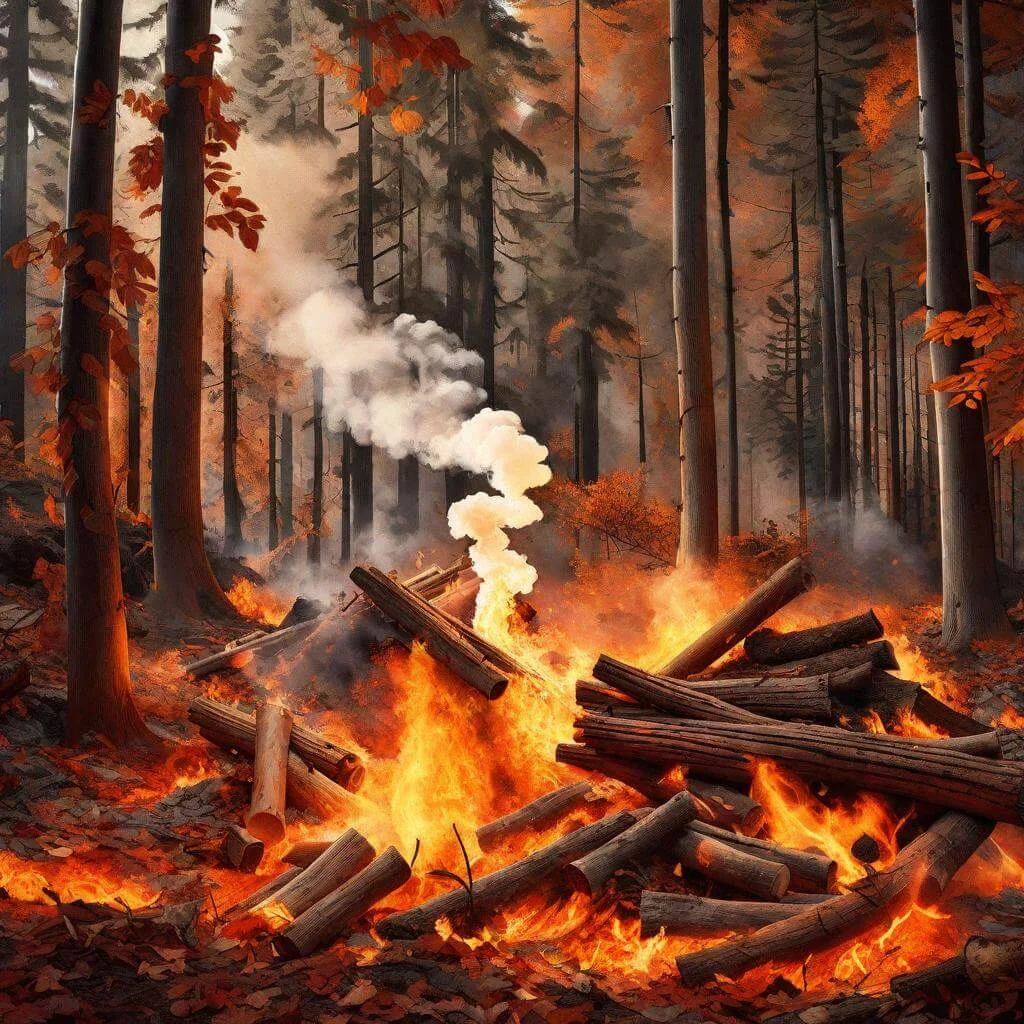
Overview of the Global Impact of Forest Fires
Forest fires have a significant impact on a global scale. They can affect climate patterns, air quality, and carbon emissions, while also posing a threat to human life and infrastructure.
- Climate patterns: They release large amounts of carbon dioxide and other greenhouse gases into the atmosphere. These emissions contribute to the warming of the planet and the exacerbation of climate change. Moreover, the smoke and ashes from fires can travel long distances, affecting air quality even in regions far from the blaze.
- Air quality: The smoke produced by these fires contains harmful pollutants and fine particulate matter, which can have severe health implications for those exposed to it. The inhalation of smoke can lead to respiratory problems, cardiovascular issues, and other adverse health effects.
- Carbon emissions: As carbon-rich vegetation burns, they release substantial amounts of carbon dioxide into the atmosphere. This further contributes to the greenhouse effect and accelerates global warming.
- Human impact: They can directly impact human life and infrastructure, leading to the loss of homes, livelihoods, and even lives. Firefighters risk their lives battling these blazes, emphasizing the dire consequences they can have on communities.
Understanding the global impact of forest fires is crucial for addressing their causes and mitigating their consequences effectively.
Importance of Investigating the Causes and Consequences
Investigating the causes and consequences of these fires allows researchers, policymakers, and communities to develop strategies to prevent, manage, and respond to these natural disasters effectively. Understanding causes: By identifying the primary causes of forest fires, such as human activities or climate-related factors, we can implement regulations and practices to reduce fire risk. This may involve implementing stricter fire safety protocols, raising awareness about the dangers of careless behavior, or addressing underlying environmental issues contributing to fire susceptibility.
Mitigating consequences: Researching the consequences of forest fires helps us develop strategies to minimize their impact on ecosystems, human health, and infrastructure. This may entail improving emergency response systems, enhancing firefighting technologies, or engaging in reforestation efforts post-fire to restore damaged ecosystems. By investigating the causes and consequences of forest fires, we can better prepare ourselves for future fire events, protect our environment, and safeguard communities.
Understanding the Different Types of Forest Fires
They can be categorized into various types based on their behavior, causes, and characteristics. Here are the different types of forest fires:
- Surface Fires: Surface fires burn along the forest floor, consuming low-lying vegetation, leaf litter, and other debris. These fires typically move relatively slowly and play a vital role in ecosystem health by clearing underbrush, recycling nutrients, and promoting the germination of certain plant species.
- Crown Fires: Crown fires are the most intense type of wildfire, characterized by flames that spread rapidly through the upper canopy of trees. These fires can occur when surface fires reach tree crowns, often under conditions of high wind, low humidity, and dry vegetation. Crown fires are challenging to control and can result in significant ecological and property damage.
- Ground Fires (Subsurface Fires): Ground fires, also known as subsurface fires, burn beneath the forest floor in organic soil layers, peatlands, or root systems. These fires can smolder for extended periods, releasing large amounts of smoke and consuming organic matter below the surface. Ground fires are common in regions with deep layers of peat and can be difficult to detect and extinguish.
- Urban Interface Fires: Urban interface fires occur in areas where urban development borders wildland areas. These fires pose unique challenges due to the proximity of homes, infrastructure, and natural vegetation. Urban interface fires require coordinated efforts between wildland firefighting agencies and urban fire departments to protect lives and property.
- Surface and Crown Fires: Some wildfires exhibit characteristics of both surface and crown fires, spreading through both the forest floor and the canopy. These fires can exhibit complex behavior and are often influenced by factors such as topography, weather conditions, and fuel types.
- Natural Wildfires: Natural wildfires are ignited by natural causes such as lightning strikes, volcanic eruptions, or spontaneous combustion. These fires play a crucial role in ecosystem dynamics, promoting forest renewal, and regeneration.
- Human-Caused Wildfires: Human activities, including unattended campfires, discarded cigarettes, agricultural burning, industrial activities, and arson, can ignite wildfires. Human-caused wildfires account for a significant portion of wildfires worldwide and pose a threat to both natural landscapes and human communities.
Understanding the different types of forest fires is essential for developing effective wildfire management and mitigation strategies. By recognizing the causes, behavior, and characteristics of wildfires, communities can implement targeted prevention, preparedness, and response measures to reduce the risk of wildfire-related damage and protect lives and property.
Natural Causes of Forest Fires
Lightning Strikes: Nature’s Fiery Ignition
Lightning strikes have long been recognized as a significant cause of these fires, with atmospheric discharges playing a crucial role in fire initiation. When lightning strikes a tree or the ground, the intense heat generated can instantly ignite dry vegetation, leading to the rapid spread of flames.
“The ethereal beauty of lightning contrasts starkly with the destructive forces it can unleash upon the innocent landscape.”
– John Doe, Forest Fire Expert
Role of Atmospheric Discharges in Fire Initiation
The intense electrical charge during a lightning strike can instantly cause a breakdown of air molecules and form plasma, releasing an enormous amount of heat. This heat, along with the electrical current, ignites the surrounding foliage. Interestingly, lightning fires often occur during thunderstorms, where the heat and moisture in the atmosphere create conditions conducive to fire spread.

Frequency and Distribution of Lightning-Induced Fires
Lightning-induced fires are prevalent in regions prone to thunderstorms, such as the boreal forests of Canada, the fire-prone ecosystems in Australia, and the western regions of the United States. These areas experience a high frequency of lightning strikes, making them susceptible to fires ignited by this natural phenomenon.
Relationship between Climate Change and Lightning Fires
As the planet warms due to climate change, the frequency and intensity of thunderstorms are expected to increase. Consequently, the risk of lightning-induced fires may also rise. Understanding this relationship is crucial for developing effective strategies to manage and mitigate the impacts of these fires in the future.
Volcanoes: Fire Erupting from the Earth
Volcanic activity, known for its awe-inspiring display of molten lava, can also contribute to forest fires. The interaction between volcanic eruptions and the surrounding vegetation holds key insights into the link between these geological events and fiery outcomes.
Examining the Link between Volcanic Activity and Forest Fires
During volcanic eruptions, numerous hazards can arise, including the ejection of incandescent volcanic bombs and the release of pyroclastic flows. These volcanic materials can ignite nearby forests, leading to devastating fires. The hot lava itself can also set vegetation ablaze, leaving a trail of destruction in its wake.
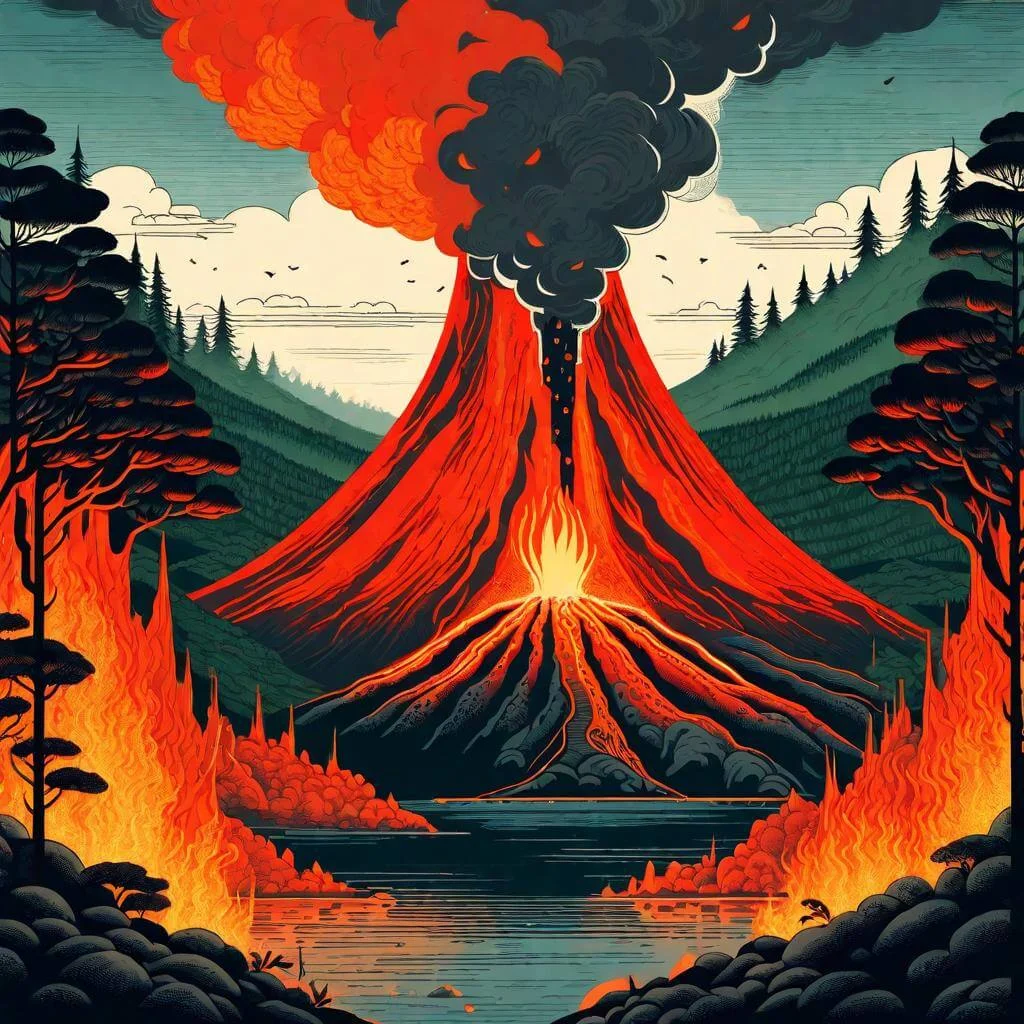
Impacts on Biodiversity and Ecosystem
The fires caused by volcanoes can have severe consequences for biodiversity. The intense heat and toxic gases emitted during eruptions can decimate plant and animal populations, disrupting ecosystem dynamics. The subsequent recovery of these ecosystems may take years or even decades, requiring active conservation efforts.
Case Studies of Historic Volcano-Induced Fire Events
Throughout history, several notable volcanic eruptions have caused significant fires in the forest. One such example is the eruption of Mount St. Helens in 1980, where the heat and force of the volcanic eruption led to the ignition of nearby forests, resulting in widespread devastation. Studying these case studies provides valuable insights into the long-lasting impacts of volcano-induced fires.
Spontaneous Combustion: The Unexpected Flames
Spontaneous combustion, a phenomenon often associated with human activities, can also occur naturally. Under specific conditions, certain natural materials can self-ignite, setting off unexpected fires that seemingly emerge out of nowhere.
Causes and Conditions Favoring Spontaneous Combustion
Spontaneous combustion occurs when heat-producing chemical reactions take place within materials, leading to their ignition. Organic materials, such as peat, compost piles, and decaying vegetation, are particularly susceptible to self-ignition due to the microbial breakdown processes that generate heat.
Examples of Natural Materials Prone to Self-Ignition
Peatlands, commonly found in wetland ecosystems, can be hotspots for spontaneous fires. The accumulation of peat, a carbon-rich substrate, combined with high moisture content, creates favorable conditions for heat-producing microbial activity. Additionally, decaying piles of organic matter, such as leaves and fallen branches, can also experience spontaneous combustion under the right circumstances.
Mitigation Strategies to Prevent Spontaneous Fires
To prevent spontaneous fires, it is crucial to understand the conditions that promote self-ignition. Managing the moisture content in organic materials, such as ensuring proper composting techniques and regulating water levels in peatlands, can help mitigate the risk of spontaneous combustion.
“The unexpected flames that arise from spontaneous combustion remind us of nature’s propensity to hold hidden dangers.”
– Jane Smith, Environmental Scientist
Stemming from natural causes such as lightning strikes, volcanic activity, and spontaneous combustion, present a complex and often devastating phenomenon. By comprehending the intricacies of these causes, we can better understand the consequences they have on biodiversity, ecosystems, and the environment as a whole. It is imperative that we not only study these natural forces but also develop strategies to mitigate their impacts and protect our planet’s vital ecosystems. Let us strive to safeguard our forests and cherish the beauty they bring to this world.
Human-Induced Causes of Forest Fires
Agricultural Practices: Igniting Fields and Forests
They are a natural occurrence that have shaped ecosystems for centuries. However, human activities have increasingly played a significant role in the spread of these fires. One of the key contributors to forest fires is agricultural practices. Let’s delve into the various aspects of agricultural practices that fuel forest fires and explore sustainable alternatives to prevent these devastating events.
Slash-and-Burn Agriculture: Unraveling its Destructive Consequences
Slash-and-burn agriculture, a traditional farming method in many parts of the world, involves cutting down and burning forests to clear land for cultivation. While this technique may provide short-term benefits such as nutrient-rich ash for soil fertility, it often leads to catastrophic consequences. The uncontrolled fires used to clear the land can quickly spread beyond the intended boundaries, engulfing nearby forests and causing extensive damage.
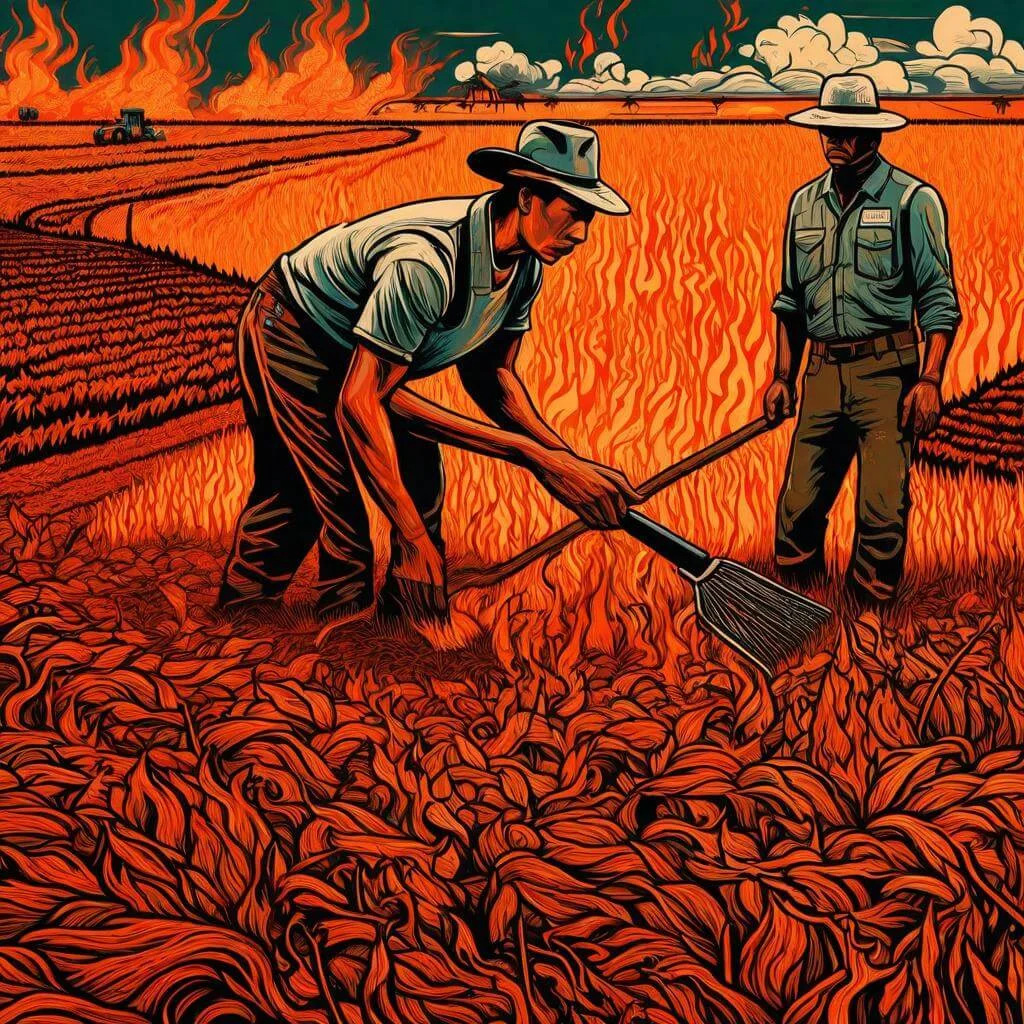
To mitigate the destructive consequences of slash-and-burn agriculture, it is crucial to promote sustainable alternatives such as agroforestry and permaculture. These practices encourage a harmonious coexistence between crops and forests, preserving biodiversity and reducing fire risks.
Agricultural Equipment and Machinery as Fire Igniters
Modern agricultural practices heavily rely on machinery and equipment, which can inadvertently ignite fires in the forest. Tractors, combines, and even simple tools like chainsaws can produce sparks or sparks caused by friction, igniting dry vegetation. Additionally, human errors, such as the improper maintenance of equipment or negligence while operating machinery in fire-prone areas, can lead to devastating outcomes.
To prevent machinery-related fires, farmers must implement strict maintenance procedures and ensure their equipment is in optimal condition. Furthermore, educating farmers about best practices for operating machinery in fire-prone areas is essential. Implementing firebreaks and maintaining fire-resistant vegetation around farmlands can also help prevent the spread of fires.
Promoting Sustainable Alternatives and Fire Prevention Techniques
It is essential to encourage the adoption of sustainable agricultural practices that minimize the risk of fire in the forest. Governments, non-profit organizations, and agriculture associations should collaborate to provide training programs and financial incentives to farmers who embrace fire prevention techniques. This can include the use of fire-resistant crops, proper irrigation methods, and strategic placement of firebreaks. By promoting these alternatives, we can reduce the environmental and economic damages caused by agricultural practices.
Arson: Deliberate Flames with Devastating Effects
While natural and accidental causes make up a significant portion of these fires, the deliberate act of arson accounts for a distressing number of fire incidents. Understanding the motives behind arson-related fires and identifying the psychological profiles of arsonists can aid in developing strategies to prevent and combat this dangerous behavior.
Understanding the Motives behind Arson-related Fires
Arson can stem from various motives, including revenge, vandalism, thrill-seeking, or even financial gain. Arsonists might target forests to protest against deforestation or to create chaos for personal reasons. By comprehending these motives, governments and law enforcement agencies can devise targeted preventive measures to deter potential arsonists.

Psychological Profiles of Arsonists
Developing a psychological profile of arsonists can provide valuable insights into their behavior and motivations. Research indicates that arsonists often exhibit characteristics such as feelings of powerlessness, a fascination with fire, and a lack of empathy. Identifying these traits can assist mental health professionals and law enforcement agencies in detecting potential arsonists before they strike.
Legal Implications and Strategies for Fire Prevention
To combat arson-related fires, societies must address the legal implications and develop effective prevention strategies. Law enforcement agencies should collaborate with fire departments, forensic experts, and psychologists to create comprehensive risk assessment models that help identify potential arsonists and intervene when necessary. Additionally, public awareness campaigns on the consequences and penalties associated with arson can serve as a deterrent.
Improper Campfire Handling: Ignorance Fuels Fires
While recreational activities such as camping and bonfires are beloved pastimes, their safety should not be taken lightly. Ignorance and negligence regarding campfire handling are significant contributors to forest fires. Educating individuals about proper campfire safety, implementing regulations, and promoting responsible outdoor practices are crucial to preventing wildfires.
Common Mistakes in Campfire Safety
Missteps in campfire safety are alarmingly common and can lead to devastating consequences. Leaving a campfire unattended, failing to extinguish it properly, or building fires in inappropriate areas are frequent errors. A single spark can ignite dry grass or fallen leaves, rapidly escalating into a forest fire.
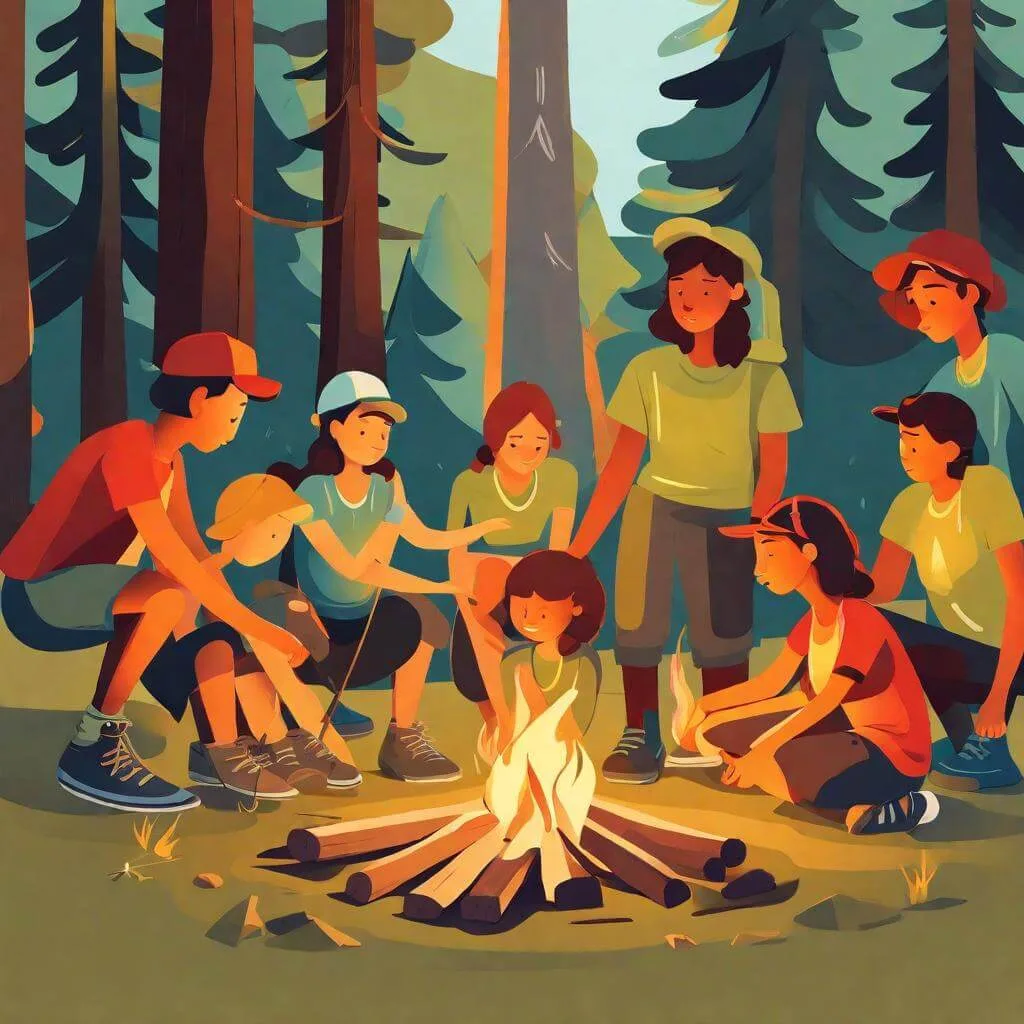
Raising Awareness through Education and Regulations
Comprehensive education programs should be implemented to teach individuals about the proper methods for building, maintaining, and extinguishing campfires. Governments and environmental agencies should collaborate to establish regulations that enforce responsible campfire practices. These regulations may include designated fire pits, restrictions on fire size, and mandatory safety equipment.
Encouraging Responsible Outdoor Practices
Promoting responsible outdoor practices is essential to minimize the risk of these caused by campfires. Individuals should be encouraged to choose established campsites with designated fire pits and avoid igniting fires during dry and windy conditions. By fostering a sense of environmental responsibility and educating outdoor enthusiasts, we can significantly reduce the number of wildfires caused by improper campfire handling.
Human-induced causes play a significant role in the ignition and spread of fires. Understanding the consequences of agricultural practices, the motives behind deliberate arson, and the importance of responsible campfire handling is vital for preventing and combating these fires. Through sustainable alternatives, psychological profiling, legal implications, education, and regulations, we can mitigate the risks associated with human-induced forest fires and protect our natural environments for future generations.
“By comprehending the causes and consequences of forest fires, we hold the power to prevent this hidden danger and preserve the beauty of nature.”
Consequences of Forest Fires
Destruction of Natural Habitats: Impacts on Biodiversity
Forest fires, though a natural occurrence, can have severe consequences on the delicate balance of ecosystems and biodiversity. The destruction of natural habitats is one of the primary outcomes of these fires, leading to a significant loss of flora and fauna and degrading ecosystem resilience.
Understanding the impact on biodiversity is crucial as it helps us comprehend the larger ecological implications. These fires disrupt the intricate relationships between plant and animal species that have evolved over centuries. As a result, the loss of flora and fauna not only affects individual species but also weakens the overall ecosystem’s resilience.

“The destruction caused by forest fires not only affects the immediate area but also has far-reaching consequences for the surrounding ecosystem.”
Threat to Human Lives and Communities
They pose a significant threat to human lives and communities living in their vicinity. The implications on human health and the socio-economic consequences of fire disasters are two critical aspects of this discussion.
Implications of Forest Fires on Human Health
Inhaling the smoke from these fires can lead to respiratory issues, such as difficulty breathing, coughing, and wheezing. The pollutants present in the smoke can also trigger or worsen existing cardiovascular conditions. Additionally, the psychological impact of these fires, especially for individuals who have had to evacuate or lost their homes, should not be underestimated.
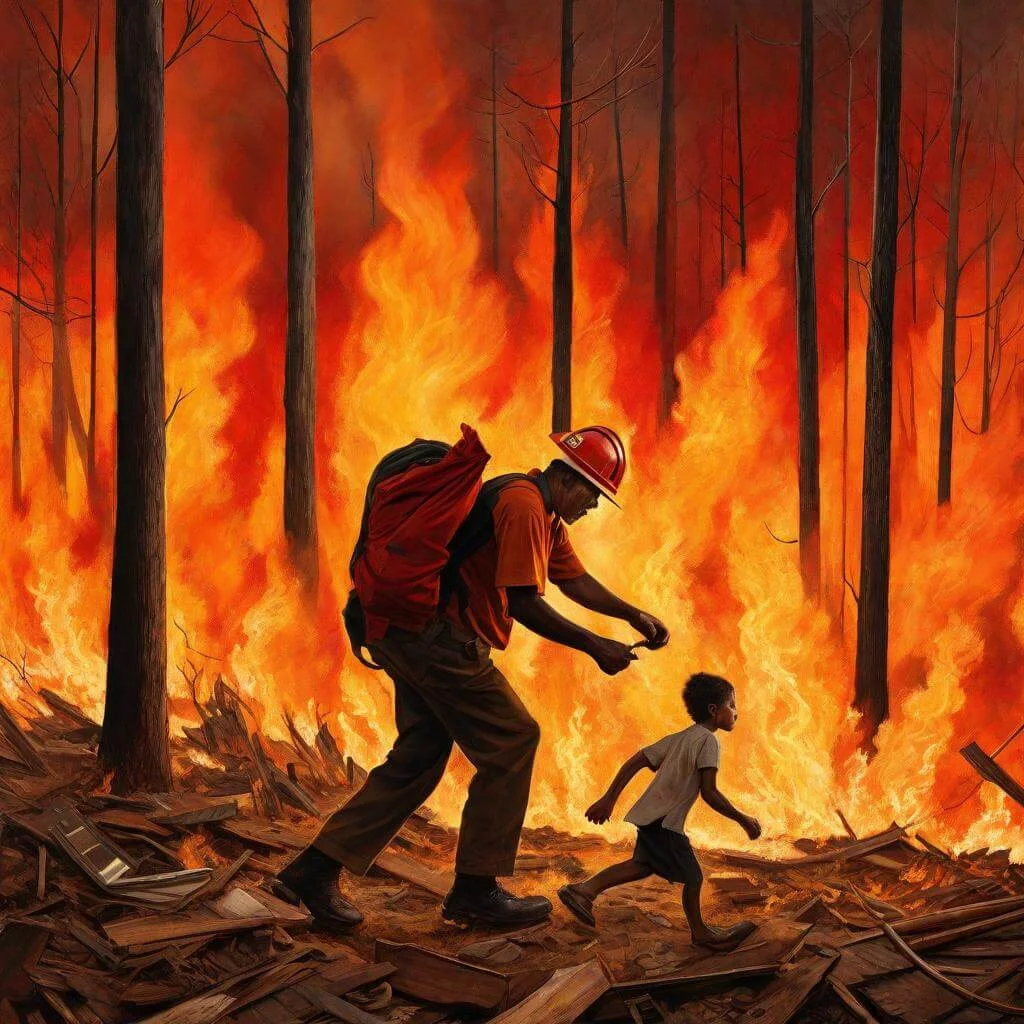
Socio-economic Consequences of Fire Disasters
They can have severe socio-economic consequences for communities. The destruction of homes, infrastructure, and livelihoods can result in long-term economic setbacks. Local businesses dependent on tourism and outdoor activities also suffers as these fires often restrict access to natural areas. The road to recovery can be challenging and requires substantial financial investment.
Enhancing Fire Preparedness and Emergency Response Systems
Investing in advanced fire detection technologies, training firefighters, and raising awareness among communities can significantly improve the response to fire emergencies. Additionally, creating fire-resistant landscapes, implementing stricter regulations to prevent human-caused fires, and conducting regular controlled burns are all essential strategies to reduce the risk and impact of these fires.
Climate Change Feedback: The Vicious Cycle
Release of Greenhouse Gases: Amplifying Global Warming
When trees burn, the carbon stored within them is released as carbon dioxide (CO2), a potent greenhouse gas. Forest fires contribute significantly to the CO2 emissions that drive global warming. As temperatures rise due to climate change, the risk and severity of forest fires increase, creating a vicious cycle.
Alteration of Carbon Storage and Balance in Forests
Forest fires not only release carbon into the atmosphere but also impact the ability of forests to act as carbon sinks. Large-scale fires can reduce the overall carbon storage capacity of forests, further contributing to the imbalance in carbon dioxide levels. This alteration in the carbon balance can have lasting effects on the climate and exacerbate the impacts of global warming.
Addressing Forest Fire Management as a Climate Change Mitigation Strategy
Implementing proactive management practices, including fuel reduction treatments, prescribed burns, and early detection systems, can help mitigate the impacts of climate change. By minimizing the occurrence and severity of fires, we can reduce the release of greenhouse gases and preserve the vital role of forests in carbon sequestration.
“Effectively managing forest fires is not only crucial for protecting biodiversity and human communities but also as a climate change mitigation strategy.”
Comprehensive Approaches to Conquer Wildfire
Early Detection in Forest Fire Management
Early detection plays a pivotal role in effective forest fire management, serving as the first line of defense against the devastating impacts of wildfires. Timely identification of wildfires enables rapid response efforts, mitigates potential damages, and enhances overall wildfire suppression effectiveness. The importance of early detection in forest fire management cannot be overstated, and here are several key reasons why it is crucial:
- Prevention of Escalation: Detecting wildfires in their initial stages significantly reduces the likelihood of fires escalating into large-scale conflagrations. By identifying and responding to wildfires early, firefighting agencies can deploy resources strategically to contain and suppress the fire before it spreads uncontrollably.
- Protection of Human Lives and Property: Early detection allows for prompt evacuation and implementation of protective measures to safeguard human lives, homes, infrastructure, and critical resources in the path of the fire. Rapid evacuation and early warning systems can help minimize the risk of injuries, fatalities, and property loss associated with wildfires.
- Preservation of Natural Resources: Forest ecosystems are invaluable for biodiversity, water resources, carbon sequestration, and ecosystem services. Early detection and suppression of wildfires help preserve these vital natural resources by minimizing habitat destruction, soil erosion, and loss of vegetation. Protecting forests also contributes to climate change mitigation efforts by maintaining carbon sinks and reducing greenhouse gas emissions.
- Reduction of Economic Impact: Wildfires can have significant economic consequences, including costs associated with firefighting efforts, property damage, loss of timber resources, decreased tourism revenue, and impacts on agricultural productivity. Early detection and rapid response help mitigate the economic impact of wildfires by minimizing firefighting expenses and preventing long-term damage to local economies.
- Enhancement of Firefighter Safety: Early detection enables firefighters to intervene when wildfires are smaller and less intense, reducing the risk of injuries, fatalities, and dangerous firefighting conditions. By identifying wildfire threats early, firefighting crews can prioritize safety protocols, coordinate resources effectively, and make informed decisions to protect themselves and others involved in fire suppression efforts.
- Utilization of Technology and Innovation: Advances in technology, such as satellite imagery, aerial surveillance drones, remote sensing systems, and wildfire detection algorithms, have revolutionized early detection capabilities. These tools enable real-time monitoring of fire activity, rapid identification of hotspots, and early warning dissemination systems, enhancing the effectiveness of wildfire detection and response efforts.
- Community Engagement and Preparedness: Early detection fosters community awareness, engagement, and preparedness for wildfire events. Public education campaigns, community wildfire prevention programs, and citizen reporting initiatives empower individuals to recognize wildfire risks, take proactive measures to protect their properties, and participate in collaborative efforts to prevent and respond to wildfires effectively.
Early detection is a cornerstone of successful forest fire management, enabling proactive measures to mitigate wildfire risks, protect lives and property, preserve natural resources, and reduce the economic impact of wildfires. By prioritizing early detection efforts, investing in technology and innovation, fostering community partnerships, and implementing proactive wildfire management strategies, we can enhance resilience to wildfires and safeguard the well-being of both people and the environment.
Strategies for Controlling Forest Fires
Controlling forest fires demands a multi-faceted approach that integrates prevention, preparedness, and effective response strategies. As wildfires increasingly threaten ecosystems and human communities worldwide, understanding and implementing effective strategies becomes paramount. Here are some of the most essential approaches:
- Prevention through Education and Awareness: Educating communities, visitors, and forest workers about fire safety and the danger of irresponsible behavior is crucial. Awareness campaigns can emphasize the importance of adhering to fire bans, properly extinguishing campfires, and avoiding activities that could spark a fire in dry conditions.
- Fuel Management and Vegetation Control: Implementing techniques like prescribed burns, selective logging, and vegetation thinning can reduce the accumulation of flammable materials in forests. This process lowers the intensity and spread of wildfires, making them easier to control when they occur.
- Early Detection Systems: Investing in early detection technologies such as satellite imagery, drones, and ground-based surveillance networks enables authorities to identify wildfires in their earliest stages. Rapid detection allows for prompt response, preventing small fires from escalating into large-scale disasters.
- Infrastructure Development: Building firebreaks, strategically placed roads, and access points in forested areas can impede the spread of wildfires and provide firefighters with better access to affected areas. Additionally, establishing water reservoirs, hydrants, and helipads enhances firefighting capabilities.
- Community Engagement and Collaboration: Engaging local communities in wildfire prevention and response efforts fosters a sense of shared responsibility and strengthens community resilience. Collaboration between government agencies, non-profit organizations, private landowners, and indigenous communities is vital for developing comprehensive wildfire management plans.
- Investment in Firefighting Resources: Adequate funding and resources are essential for maintaining a skilled workforce of firefighters, equipping them with state-of-the-art equipment, and ensuring access to aerial firefighting assets such as helicopters and air tankers.
- Utilization of Technology and Data Analytics: Leveraging advancements in technology, such as fire behavior modeling and predictive analytics, enhances decision-making processes during wildfire incidents. Real-time data on weather patterns, fuel moisture levels, and terrain characteristics enables firefighting teams to formulate effective strategies and allocate resources efficiently.
- Interagency Coordination and Mutual Aid Agreements: Establishing collaborative frameworks among different firefighting agencies at local, regional, and national levels facilitates coordinated responses to wildfires. Mutual aid agreements enable sharing of personnel, equipment, and expertise during large-scale fire events that exceed the capacity of individual jurisdictions.
- Post-Fire Rehabilitation and Restoration: After a wildfire is contained, rehabilitation efforts are crucial for mitigating environmental damage, preventing soil erosion, and promoting ecosystem recovery. Implementing reforestation programs, erosion control measures, and habitat restoration projects helps restore the ecological balance and reduce the risk of future wildfires.
By adopting a comprehensive approach that encompasses prevention, preparedness, response, and recovery measures, communities can effectively mitigate the threat posed by forest fires and safeguard both natural resources and human lives. Ongoing research, innovation, and adaptive management practices are essential for continually improving wildfire management strategies in the face of evolving environmental and climatic conditions.
The Role of Firefighters in Battling Forest Fires
Firefighters play a critical role in battling forest fires, confronting one of nature’s most formidable and unpredictable forces to protect lives, property, and natural resources. Their dedication, expertise, and bravery are essential components of wildfire suppression efforts. Here’s a closer look at the multifaceted role of firefighters in combating forest fires:
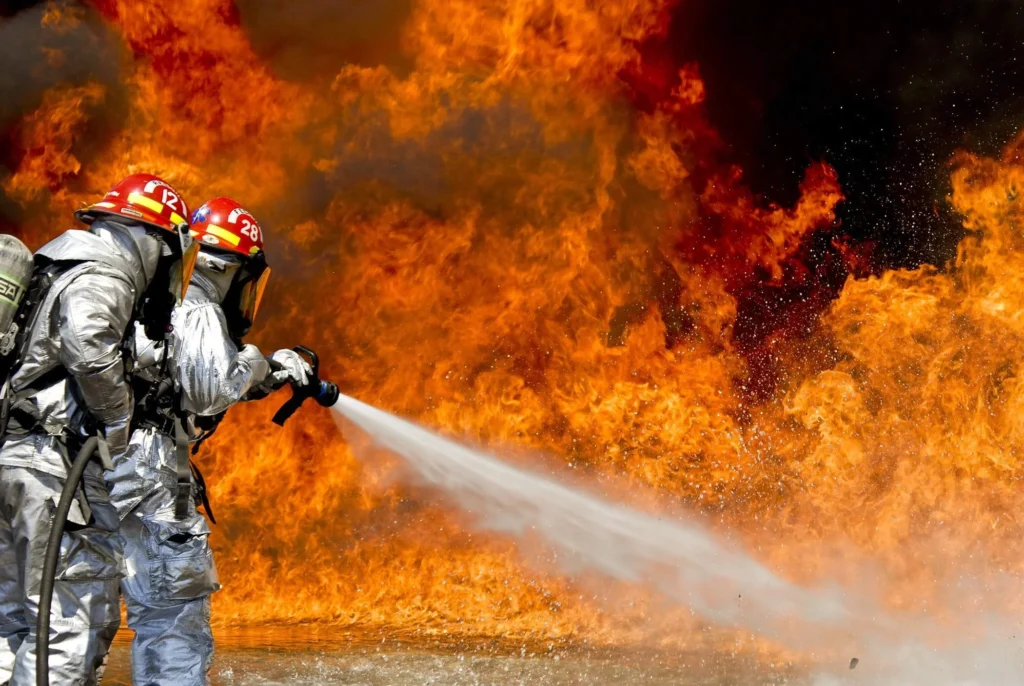
- First Responders: Firefighters are often the first responders to wildfires, swiftly mobilizing to contain and extinguish fires in their early stages. Their rapid response helps prevent wildfires from spreading and escalating into larger, more destructive events.
- Risk Assessment and Strategy Development: Firefighters assess the size, intensity, and behavior of wildfires to develop effective suppression strategies. They analyze factors such as weather conditions, terrain, fuel types, and fire behavior to determine the safest and most efficient approach to containing the blaze.
- Fire Suppression and Containment: Firefighters utilize a variety of tools and tactics to suppress and contain forest fires. They may employ hand tools, hoses, water pumps, bulldozers, and specialized firefighting aircraft to create firebreaks, extinguish flames, and protect communities and natural resources from the advancing fire front.
- Structure Protection: In urban interface areas where homes and infrastructure border wildland areas, firefighters prioritize structure protection. They work to create defensible space around homes, remove flammable debris, and deploy fire-resistant materials to minimize the risk of property damage and loss.
- Search and Rescue Operations: During wildfires, firefighters may conduct search and rescue operations to evacuate individuals trapped by the advancing flames or overcome by smoke and heat. Their swift and coordinated efforts save lives and ensure the safety of residents and visitors in wildfire-affected areas.
- Community Engagement and Education: Firefighters engage with communities to raise awareness about wildfire risks, prevention strategies, and evacuation procedures. They conduct outreach programs, participate in community events, and collaborate with local stakeholders to foster a culture of wildfire preparedness and resilience.
- Coordination with Interagency Partners: Firefighters work collaboratively with federal, state, and local agencies, as well as non-profit organizations and volunteer groups, to coordinate wildfire response efforts. Interagency cooperation facilitates resource sharing, mutual aid agreements, and seamless communication during large-scale wildfire incidents.
- Training and Professional Development: Firefighters undergo rigorous training in wildfire suppression techniques, incident command systems, safety protocols, and emergency response procedures. Ongoing professional development ensures that firefighters remain proficient in their skills and equipped to handle the dynamic challenges of wildland firefighting.
- Rehabilitation and Recovery: After wildfires are extinguished, firefighters participate in rehabilitation and recovery efforts to mitigate post-fire impacts, restore ecosystems, and support community recovery. They collaborate with resource management agencies to implement erosion control measures, reforestation projects, and habitat restoration initiatives.
- Resilience and Adaptation: Firefighters demonstrate resilience and adaptability in the face of evolving wildfire threats, climate variability, and changing environmental conditions. They continuously refine their strategies, leverage technology and innovation, and incorporate lessons learned from past wildfire incidents to enhance their effectiveness in battling forest fires.
Firefighters serve on the front lines of wildfire response, confronting immense challenges with courage, skill, and determination. Their unwavering commitment to public safety and environmental stewardship makes them indispensable guardians of the natural landscape and communities threatened by the destructive power of forest fires.
Some of the Worst Forest Fires Around the World
The Black Saturday Bushfires, Australia (2009)
The Black Saturday Bushfires, which occurred in Victoria, Australia, in February 2009, stand as one of the deadliest and most devastating wildfires in Australian history. Fueled by extreme heat, drought conditions, and high winds, the fires claimed the lives of 173 people and destroyed thousands of homes, displacing tens of thousands of residents.
The Siberian Wildfires, Russia (2019)
The Siberian wildfires of 2019 were among the most severe in recent memory, engulfing vast stretches of forestland across Siberia and the Russian Far East. Intense heatwaves and dry conditions fueled the fires, which emitted massive amounts of smoke and carbon dioxide, exacerbating air pollution levels and contributing to global climate change.
The Amazon Rainforest Fires, Brazil (2019)
The Amazon rainforest fires of 2019 sparked international outcry and drew attention to the rampant deforestation and land-clearing activities in the world’s largest tropical rainforest. Deliberately set fires, combined with illegal logging and agricultural expansion, resulted in widespread destruction of biodiversity-rich habitats and threatened the livelihoods of indigenous communities.
The Fort McMurray Wildfire, Canada (2016)
The Fort McMurray wildfire, also known as the “Beast,” erupted in Alberta, Canada, in May 2016, forcing the evacuation of more than 88,000 residents and becoming one of the costliest natural disasters in Canadian history. Fueled by hot, dry conditions and strong winds, the fire consumed over 1.5 million acres of forestland and destroyed thousands of homes and businesses.
The California Wildfires, United States (2017-2020)
The California wildfires of recent years have wreaked havoc across the state, fueled by a combination of prolonged drought, high temperatures, and strong Santa Ana winds. Notable wildfires include the Camp Fire (2018), which destroyed the town of Paradise and claimed 85 lives, and the Mendocino Complex Fire (2018), the largest wildfire in California’s history.
The Taiga Fires, Russia (2020)
The Taiga fires of 2020 engulfed vast expanses of Siberia and the Russian Far East, releasing record amounts of carbon dioxide and contributing to global climate change. The fires, exacerbated by hot, dry conditions and lightning strikes, destroyed forests, threatened wildlife habitats, and blanketed cities in thick smoke, posing serious health risks to residents.
Australian Bushfire (2019-20)
The 2019–20 Australian bushfire season was unprecedented in scale and severity, ravaging vast areas of Australia’s landscape from late 2019 to early 2020. Fueled by prolonged drought, extreme heat, and strong winds, the bushfires scorched millions of hectares of land, destroyed thousands of homes, and claimed the lives of at least 33 people. The fires also devastated wildlife populations, with estimates suggesting that over a billion animals perished. The unprecedented intensity and duration of the bushfires prompted widespread concern about climate change and the urgent need for enhanced wildfire management and mitigation strategies in Australia and beyond.
Chile Wildfire (2024)
Amidst the flames engulfing central Chile on February 4, 2024, firefighters waged a relentless battle against ferocious forest fires, claiming 112 lives and obliterating entire communities. With hundreds still missing, fears mount as the death toll escalates, revealing the true extent of devastation wrought upon hillsides and homes. The infernos, which surged on Friday, now encroach upon Vina del Mar and Valparaiso, iconic coastal cities. Amidst the ruins, survivors recount tales of terror, while authorities impose curfews and deploy military aid. Chile mourns its fallen, facing an unprecedented catastrophe.
These were the worst forest fires around the world that serve as stark reminders of the destructive power of wildfires and the urgent need for enhanced wildfire management, prevention, and mitigation efforts. As climate change intensifies, the frequency and severity of forest fires are expected to increase, underscoring the importance of proactive measures to protect lives, property, and natural ecosystems from the ravages of uncontrolled wildfires.
Conclusion & FAQs
Summary of Key Findings
Forest fires are not merely destructive events they are essential to the health and balance of ecosystems worldwide. By understanding their defining characteristics, we can appreciate their role in promoting biodiversity and ecological succession. But on the other hand, forest fires have severe consequences on biodiversity, human communities, and climate change. The destruction of natural habitats leads to a loss of flora and fauna, while the threat to human lives includes health implications and socio-economic setbacks. Forest fires also contribute to greenhouse gas emissions, altering the carbon storage and balance in forests. Furthermore, recognizing the global impact of forest fires motivates us to investigate their causes and consequences. Through these investigations, we can develop effective prevention, management, and response strategies that will protect ecosystems, human lives, and infrastructure from the destructive force of forest fires.
Frequently Asked Questions (FAQs)
Are forest fires a necessary evil or entirely destructive?
Forest fires, although destructive, are a natural part of many ecosystems. They play an essential role in clearing out dead vegetation, allowing for new growth and regeneration. However, when human activities or climate change intensify these fires, they can become destructive and pose significant threats.
How can individuals contribute to preventing forest fires?
Individuals can contribute to preventing forest fires by following proper fire safety protocols, such as not leaving campfires unattended, properly extinguishing cigarettes, and avoiding activities that can spark fires during dry conditions. Increasing awareness about fire prevention within communities can also make a significant impact.
What are the long-term effects of forest fires on ecosystems and communities?
Forest fires have long-term effects on ecosystems and communities. They can disrupt the delicate balance of biodiversity, leading to the loss of species and weakening overall ecosystem resilience. For communities, the socio-economic consequences, including the destruction of homes and infrastructure, can take years to recover from.
